What Architects Need to Know About Specifying Wood Doors
A primer on door components, construction, aesthetics, and sustainability
![]() Continuing Education
Continuing Education
Use the following learning objectives to focus your study while reading this month’s Continuing Education article.
Learning Objectives - After reading this article, you will be able to:
- Discuss the basic components of an architectural wood door and explain the function of each.
- Compare the features, options, and benefits of wood door construction materials.
- Describe wood door assembly and construction methods from a durability standpoint.
- Name the industry performance standards that relate to wood door design and aesthetics.
Doors are a critical part of every building, and there are a plethora of options to satisfy a variety of needs. Today's marketplace is flooded with so many choices in types and styles of wood doors that selecting the right door for a given situation can often be a time-consuming and perplexing process. Yet properly specified doors go a long way to achieving the aesthetic, functional, safety, and environmental requisites that enhance the look and durability of a commercial space. Architects and design professionals who are researching, comparing, selecting, and specifying wood doors should be equipped with an understanding of the basic anatomy of a door, and the function of all constituent parts as well as a knowledge of industry standards that must be met. This article will serve as a primer on wood doors, their components, and construction methods and how to achieve optimum results from the perspective of performance, aesthetic, and environmental concerns.
Anatomy of a Door
Architectural wood doors are assembled products comprised of multiple components, each with its own purpose. All doors consist of:
- A core, the main component, and innermost layer.
- Stiles, the vertical lock, and hinge edges.
- Rails, the top, and bottom edges.
- Face materials, the outermost layer.
Depending on the door construction process, two additional components may be included. Crossbands are materials placed between the core assembly and face material, and backers, which are materials applied to the crossbands opposite the face.
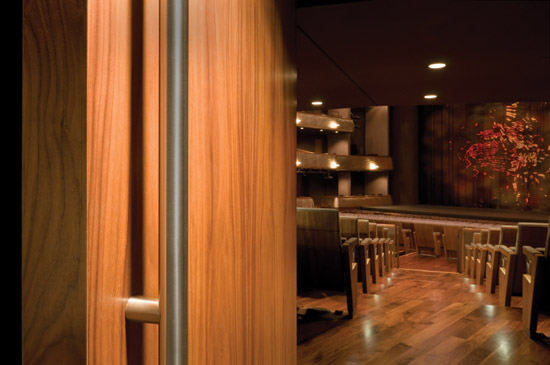 |
Properly specified doors help achieve the aesthetic, functional, safety, and environmental requisites that enhance the look and durability of a commercial space. Photo courtesy of VT Industries, Inc. |
In the architectural wood door construction industry the term “ply” is used to identify wood door components. The number of ply in door construction is distinguished by the number of layers of material in the door, which may be 3, 5, 7 or 11. The number of ply may also determine the technology and technique used to manufacture the door. The core of the door is counted as one ply, with each extra component counted as additional ply. Symmetry, or equal ply surrounding the core, is important to avoid any warping during the manufacturing process.
Architects should note, however, that three-ply door construction, which consists of a core assembly and face materials attached to either side of the core, is not considered as stable or as durable as doors with more ply. Three-ply construction is primarily used for high-pressure decorative laminate doors in architectural applications such as office spaces or other low-use areas.
Three-ply doors are often not available with wood veneer face materials since the core may show or “telegraph” through the face laminate and distract from the door's aesthetic appeal.
For architectural applications, such as hospitals, full-service hotels, and class A offices, five-ply wood door construction is the most commonly used method and is preferred by many architects because the crossbands provide increased stability, the face veneer is thicker than seven-ply, and the manufacturing technique provides a strong, durable bond between the ply. Seven-ply wood doors, which include a core, backer materials, crossbands, and thinner face materials, are commonly used for commercial applications. Nine- and 11-ply doors are generally residential doors.
Before delving further into door components, it is important to understand some fundamentals about performance standards. The Window and Door Manufacturers Association (WDMA, www.wdma.com) defines the standards of performance for windows, doors, and skylights in the residential and commercial building sectors and increases awareness of these standards among industry members by providing resources and educational professional programs.
WDMA standards for doors cover the aesthetics, performance (duty level, dimensional tolerance, flame spread), testing requirements, construction, and finishing expectations for a door for a particular opening. In 2011, the WDMA released two updated editions of its architectural wood flush door standards, the WDMA I.S. 1A-11, Industry Standard for Architectural Wood Flush Doors, and WDMA I.S. 6A-11, Industry Standard for Architectural Stile and Rail Doors. In addition, in 2011, WDMA established a new council, the WDMA National Architectural Door Council™ (NADC), to represent the interests of the leading manufacturers of architectural door manufacturers and their suppliers. In a three-fold mission, the council will not only develop and maintain industry standards for architectural wood doors, it will represent the industry before code and regulatory bodies, and the media, and promote WDMA architectural door standards to architects, specifiers, and contractors.
WDMA door descriptors are used to identify construction for architectural wood doors. Manufacturers use multiple naming systems or branding for their products and the WDMA descriptors standardize these offerings. They are critical for specification writers to identify doors without using proprietary names associated with a single door manufacturer, and they offer shorthand in specifying core, core assembly, and face material recognized by the door industry. For example, PC-5 describes a particleboard core door with veneer faces using five-ply construction with stiles and rails bonded to the core. PC-HPDL-5 is the same as above with high-pressure decorative laminate faces. An “F” is added to the descriptors to identify a non-bonded core assembly.
 |
Commonly used for commercial applications, seven-ply wood doors include a core, backer materials, crossbands, and thinner face materials. Image courtesy of VT Industries, Inc. |
WDMA also specifies performance duty levels for architectural wood doors. The Extra Heavy-Duty level typically involves doors where use is considered heavy and frequent, and requires the highest minimum performance standards. Applications include classrooms, patient rooms, public bathrooms, dormitory rooms, auditorium entry, detention and correctional facilities, gymnasiums, locker rooms, and surgical entry/trauma centers. The Heavy-Duty designation typically involves doors where usage is moderate, and requires intermediate minimum performance standards. Applications here include assisted living room entry, office-interior passage, stairwell, mechanical service, hallway, hotel/motel room entry, storage, apartment/condo entry, X-ray, acoustic, or medical examination rooms. Finally, the Standard Duty level typically involves doors where frequency of use is low, and requires the lowest minimum performance standards. Usages may include a closet, wardrobe, private bathroom, or low-usage office.
Core Options
Since the core is the main component of a wood door, depending on the application and project requirements, the core material must provide durability, a fire rating, hardware, and meet environmental and acoustical performance expectations.
Particleboard. Composed of 100 percent recycled wood fiber, particleboard is the most widely specified core material and has been an industry standard for over 30 years. It is suitable for most construction requirements and is available in three-, five-, and seven-ply construction. Particleboard has screw-holding capability for closers and exit devices without through bolting, and it meets ANSI A208.1 Performance Duty and WDMA Heavy-Duty Level requirements without blocking, a material used for improved screw holding at hardware attachment points and used to replace the core material at specific locations where the core material does not meet applicable performance duty levels. Particleboard can also be fire rated up to 20 minutes, positive pressure. It's also important to note that positive pressure fire doors and openings typically require an intumescent seal or gasket applied either to the frame or concealed within the door itself.
Agrifiber core. Newer to the industry, agrifiber is made from fibrous agricultural products such as wheat and soybean stalks. These materials are both recycled and rapidly renewable. The manufacturing process uses specialized resins with no added formaldehyde as the bonding agent. Agrifiber core doors are interchangeable with wood particleboard as they meet the same ANSI A208.1 and WDMA Heavy-Duty levels and have the same WDMA door descriptors with positive pressure fire ratings up to 45 minutes.
Stave lumber core. This material is made from wood blocks or strips from drop-off material from other wood products that are glued together to form a core material. Before advanced engineered material cores were produced, stave lumber was the standard core material for wood doors. Today stave lumber cores can be Forest Stewardship Council (FSC) certified. There are drawbacks to stave lumber cores, however. The material is dry and will take on moisture differently from piece to piece, making the door susceptible to twisting and warping. Also, the lumber is subject to volatile availability demands, making it harder to get at certain times of the year.
Structural composite lumber (SCL) core. Made from small diameter hardwood trees, SCL uses the entire log so there is little waste of natural resources. Also referred to as laminated strand lumber (LSL), SCL is the most stable core material, weighs more than particleboard, does not require costly inner blocking to meet WDMA Extra Heavy-Duty levels, and has exceptional screw-holding capabilities. SCL core doors are available from some manufacturers in a 45-minute fire rating.
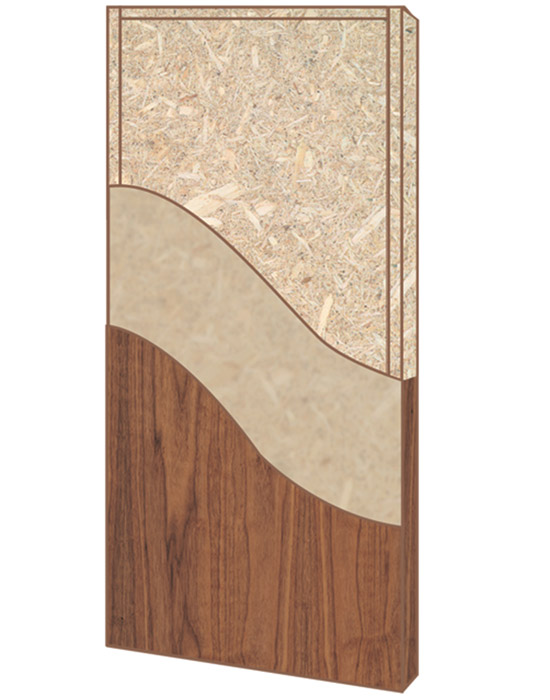 |
Structural Composite Lumber (SCL) Core Image courtesy of VT Industries, Inc. |
Fire-retardant core. Made from a non-combustible material, typically gypsum based, fire-retardant cores must meet rigorous smoke, flame, and pressure tests, and are available up to 90-minute positive pressure ratings required to meet building fire codes for the life safety of building occupants.
Specialty construction cores. These cores are available for acoustic and lead-lined doors. Acoustical doors may range in thickness from 1¾ inches to 2¼ inches and are constructed to provide increased acoustical performance over standard core materials, though Sound Transmission Class (STC) ratings vary by manufacturer and type of construction. However, STC doors do require lite kits to be factory installed, and pairs of doors will void STC ratings. Lead can be applied to doors under the crossbanding material to provide radiation protection, with lead thickness varying by specific application requirements.
Stiles and Rails
Stiles and rails are composed of SCL, hardwood, or softwood materials, with SCL providing the best screw-holding capabilities and stability. Inner SCL stiles with matching outer hardwood stiles will meet both performance and aesthetic expectations.
Crossbands
Crossbands are applied to prevent telegraphing of the stile and rail through the face material and provide stability to the door. A crossband is a ply placed between the core and face veneer in five-ply construction and a ply placed between the back and face of a three-ply skin in seven-ply construction. Natural wood crossband materials are not recommended since colors may range from white to very dark, which could show through on light veneers. In addition, voids and lapped crossbands can occur, which are not acceptable under WDMA standards. Engineered wood crossbands, commonly made from high-density fiberboard (HDF), are durable, meet all industry standards, and have a uniform quality and appearance that will not show through the veneer. With this option, the possibility of delamination is eliminated with the consistent surface.
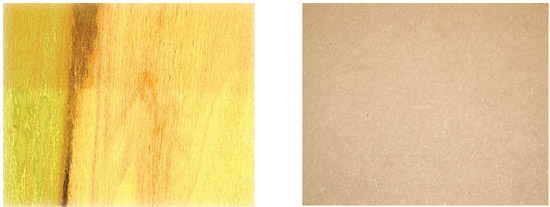 |
Crossbands: A Comparison Images courtesy of VT Industries, Inc. |
Face Options
Both AWS and WDMA quality standards recognize multiple face material options.
Wood veneers. Wood veneers are available in multiple grades, matches, and assemblies to meet design requirements, including domestic and exotic selections. Natural variations of the veneer and different cuts create unique textures, grains, figure, and color for each veneer piece and door. While seven-ply construction with three-ply skins is only available in limited species, many species are available including exotic veneers for five-ply construction. Plain sliced or flat cut, quarter sliced, rift cut, and rotary are common veneer cutting methods. Door manufacturers follow WDMA standards for veneer grades, which are adapted from the Hardwood Plywood Veneer Association (HPVA, www.hpva.org).
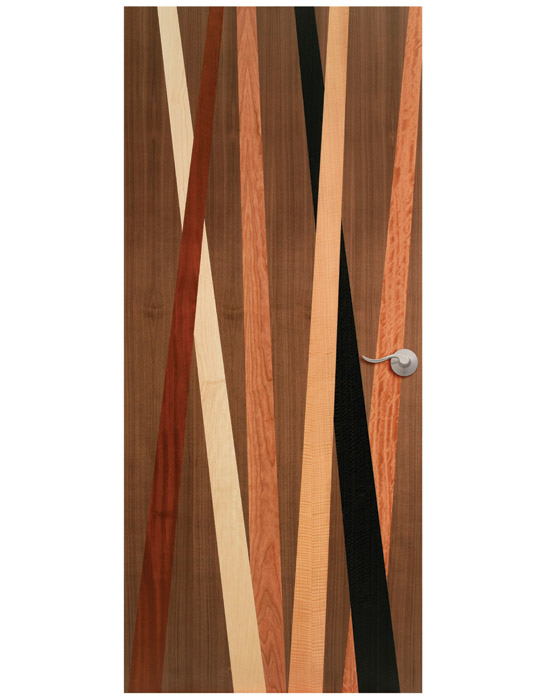 |
Wood Veneer Door Image courtesy of VT Industries, Inc. |
High-pressure decorative laminate (HPDL). Offering endless design possibilities and increased durability over wood veneer, HPDL faces are consistent, durable, cost effective, and available with custom designs and in a full array of patterns, solid colors, and wood grain finishes. HPDL doors do not require on-site staining, sealing, or painting and have minimal maintenance costs. Edge-before-face construction minimizes the appearance of seams and reduces chipping by limiting potential contact areas.
Paintable surfaces. Mill option paintable surfaces provide paintable options and a uniform surface with no raised grain, knots, or flaws for opaque finishes. Doors are available pre-primed, reducing the need to sand or prime in the field.
Fiber-reinforced laminate (FRL). FRL is ideal for highest-traffic applications, such as schools, hospitals, and hospitality, because of stain resistance and increased durability over other face materials. FRL outperforms other engineered face materials in wear resistance and is available in a variety of patterns and wood grains, similar to those available with HPDL.
Door Construction and Assembly
There are a variety of door construction and assembly methods, each with its own benefits.
Hot and Cold Press
Architectural wood doors are constructed using hot press or cold press technology. Controlling the press process is key to door manufacturing consistency and in most cases, certain factors during the cold press process are uncontrollable. In order to assure the greatest degree of control, consistency, and quality in door construction, the hot press technique is preferable.
Hot press technology involves pressing each door individually in a platen under controlled pressure, temperature, and time, based on the type and thickness of material. Hot press produces a uniform bond and uses Type 1 water proof glue versus Type II which is water resistant. Hot press is commonly used for the construction of three- and five-ply doors. Cold press technology, on the other hand, involves pressing a stack or pile of doors, one on top of another, at ambient building temperatures until the adhesives are cured. Depending on the surrounding temperature and humidity conditions, cold pressing takes much longer than hot pressing, and cannot produce doors of equal quantity or quality. With cold pressing, the pressure is uneven and the bottom door in the pile receives more pressure than the top one. In addition, the skins for cold pressing are often outsourced, leading to further loss of control.
Drop-In Assembly
Drop-in core assembly is commonly used in seven-ply door construction and entails dropping the core material into a pre-assembled wood frame. The core must be smaller than the frame which may result in gaps up to ¼ inch wide. Also, the core and frame are not bonded or glued together, or sanded as a unit. In this type of door construction, telegraphing of the door is common.
Loose Lay-Up
Loose lay-up core assembly is also commonly used in seven-ply door construction and involves placing stiles and rails loosely around a core. Because the stiles and rails are not bonded to the core prior to placement of the face materials, gaps up to ¼ inch can occur. In addition, the core, stiles, and rails are not sanded as a unit. Similar to drop-in core assembly, this construction method commonly results in doors with telegraphing.
Bonded Core
In bonded core assembly the stiles and rails are securely glued to the core prior to application of additional plies resulting in no gaps or voids. The assembled core is sanded to plus or minus 0.0005-inch thickness to create a smooth surface that limits the possibility of telegraphing. Bonded core assembly is used in both five-ply and seven-ply door construction.
Ply Construction
Seven-ply wood doors are constructed using pre-manufactured three-ply door skins. The skins consist of a face, crossband, and back veneer. They are applied to each side of a drop-in core assembly using Type II, water-resistant adhesives using cold press technology. The skins are readily available for face materials, which can be birch and oak, rotary cut or plain sliced, and mahogany, plain sliced. Exotic and AA veneer are difficult to source for three-ply skins and are often only available in book and running matched. In addition, seven-ply doors may have limited warranties.
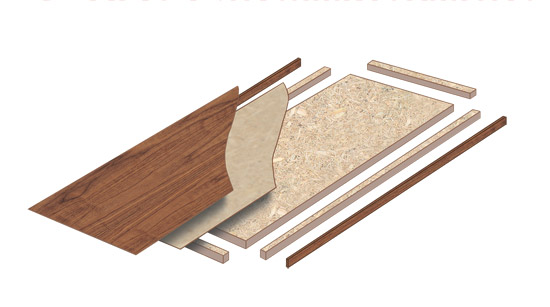 |
|
Image courtesy of VT Industries, Inc. |
Traditional five-ply doors are constructed with bonded core assembly using hot press technology. Manufacturers may offer two edge options: a compatible solid hardwood stile with exposed crossbands, or a compatible wood veneered or taped edge. Solid wood stiles are expensive and have the potential to warp and split. Also, the manufacturing process is not considered as environmentally friendly as the alternative veneered and hardwood edges because the natural resource is not fully utilized. Crossbands are exposed with the use of solid wood stiles, which create a less desired look. Wood tape edges are thin, which could lead to telegraphing issues, are easily damaged, and offer limited protection.
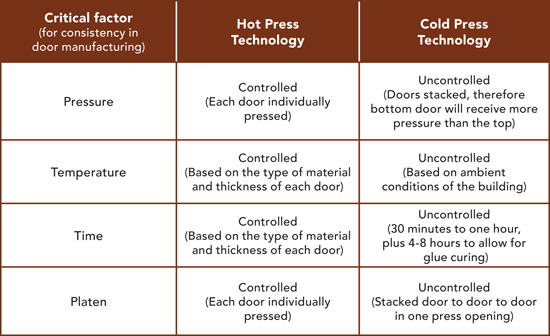 |
|
Source: VT Industries, Inc. |
Advanced edge-before-face five-ply construction incorporates bonded core assembly construction with matching hardwood edges which are applied prior to the face material. This method eliminates unsightly crossbands and produces a seamless wood appearance. Matching hardwood edges provide design integrity and durability and all the materials meet industry performance standards for edge materials.
Aesthetic Concerns
A key way to assure the aesthetics of an architectural hard wood door is to focus on veneer and how the veneer components are matched.
Matching of Veneer Components
Once the decorative veneer cutting method is specified, the type of match at the joint line must be specified. The way in which the individual cuts are placed next to each other during the fabrication of the veneer face affects the appearance and aesthetic of a door. Leaf matching and assembly matching must be considered, as well as the matching of pairs of doors, sets of doors, and doors with transoms.
Book matching . The most commonly used method to match veneer leaves in the wood architectural door industry is known as book matching. Book matching requires every other piece of veneer to be turned over so adjacent pieces, or leaves, are “opened” like the pages of a book. The veneer joints match and create a mirrored image pattern at the joint line, yielding a maximum continuity of grain. It is commonly used with plain sliced cut and less often with other cuts of veneer. A natural result of veneer slicing is the accentuation of the dark-light-dark-light appearance of the veneer. Because the “tight” and “loose” faces alternate in adjacent pieces of veneer they may accept stain or reflect light differently resulting in a noticeable color variation, often called “barber pole.” These variations are not considered a manufacturing defect.
Slip and random matching. Slip match is the adjoining of veneer components in sequence without turning over every other piece. The grain figure repeats, but joints do not show a mirrored effect. Slip matching is often used in quarter cut, rift cut, and comb grain veneers to minimize the barber pole effect. Random match produces a “board like” appearance and is not recommended for finished applications. The random selection of veneer components from one or more logs is most commonly used in opaque and “good” grade door applications.
Assembly Match
In addition to leaf matching, a type of assembly match must be specified. To obtain the desired aesthetics, any sequence matching from door opening to door opening must be detailed.
Running match. Running match is the most common type of assembly splice used. Each face is assembled from as many veneer pieces as necessary creating a non-symmetrical appearance on any single door face. Veneer pieces of unequal width are common. Running match yields the least amount of waste veneer and is recommended by WDMA Quality Standards.
Balance match. This type of match creates a symmetrical appearance. Each piece is similar in size and each face is assembled from an even or odd number of pieces of uniform width veneer before trimming. The piece in the middle of the group is centered around the mid-point of the veneer face. This type of match reduces veneer yield.
Center balance match. Also creating a symmetrical appearance, center balance matching is a technique by which each face is assembled from an even number of veneer pieces of uniform width before trimming, with a veneer joint or splice in the center of the door face. Achieving a center balance match creates the most waste veneer, because it reduces the veneer yield and is considered the least “green” choice for assembly matching. It is the most expensive in terms of waste, price, and our environment.
Doors in pairs. Wood doors may be, and in some grades, must be specified as pair matched where appropriate. Pair matching consists of using the same assembly match to pairs of doors or a series of doors pairs in the immediate vicinity. Most architectural wood door manufacturers will pair match doors unless they are produced with an opaque finish that hides the grain.
Doors in sets. Set match describes the way in which the leaves of veneer are assembled for sets of doors hung adjacently. Doors in single openings may also be set matched but this must be specified in the design document and when orders are placed so manufacturers can order veneer appropriately.
Doors with transoms. For doors with transoms, continuous matching is recommended. Continuous match means that a single piece of veneer is utilized for both the face of the door and the transom. The ability to provide this match is dictated by the length of the log. Continuous match provides optimum veneer utilization as each single piece of veneer extends from the bottom to the top of the door. In some species, 10-foot cuts of veneer may be available, but in others only shorter lengths may be obtainable.
 |
Book Running Door Image courtesy of VT Industries, Inc. |
Each face and transom of an end match door is produced from two sheets of veneer. A single piece of veneer extends from the bottom to the top of the door and a mirror image is created at the transom by turning the veneer at the joint. End matched panels are used when veneers are not long enough to cover the whole height of the door with a single face on each side. For doors with transoms, “no match” is possible but it is not typically specified in architectural wood doors since it has an undesirable, unattractive appearance.
Finishing Options
Finishes protect wood from moisture, handling damage and harsh chemicals. Factory finishing provides a consistent finish and reduces on-site VOC (volatile organic compound) emissions. Because they are applied in a controlled, clean, well-lit environment with automated sanding and staining, results are consistent. In contrast, finishes applied in the field are subject to damage and inconsistency due to jobsite conditions, construction dust, poor lighting, and hand sanding and staining. Additionally, responsibility is put on the manufacturer to provide specified color and finish results. WDMA TR-8, UV cured urethane finishes use water based stains. Sealer and top coats are UV (ultraviolet light) cured thus ensuring the product is low-emitting and safe for building occupants.
The precision of the automated factory machining process ensures a seamless installation of a wood door. It also ensures correct performance of the hardware and limits the need for machining on a fire rated door performed by a licensed machiner. Factory machining is commonly available for architectural wood doors, often at no extra cost. Some manufacturers provide value-added options such as factory applied or installed surface applied molding, glazing, louvers, finished top and bottom rails, and sealed rails. These options result in less installation time at the jobsite and ensure desirable design and performance.
Fire Ratings
Fire-rated architectural doors are available from 20- to 90-minutes in positive and neutral pressure to meet building code requirements. Category A positive pressure fire doors have concealed intumescent built into the door. No additional edge-sealing system is required with these doors. Concealed intumescent provides the same seamless elegance as non-rated doors. Architectural doors should always have the approvals and fire labels required for installation in a specific location.
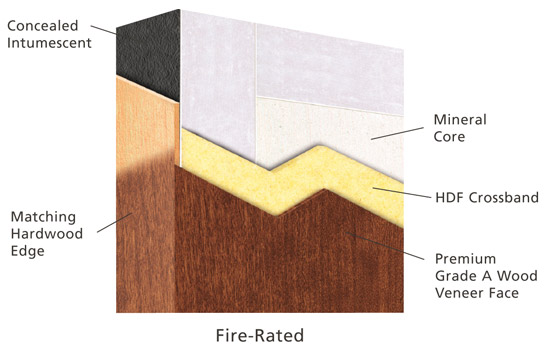 |
|
Image courtesy of VT Industries, Inc. |
| Typical Specifications |
Specifications vary by grade of door and manufacturer. The table below compares typical architectural specifications for five- and seven-ply doors. The five-ply architectural stile is 1-3/8 inch, composed of hardwood edge with the remainder of the stile being SCL (LSL) for strength, stability, and cost. The advantages of five-ply construction include face material availability, core assembly, and stile and rail performance and aesthetics. Additionally, five-ply doors are most often backed by a lifetime warranty. |
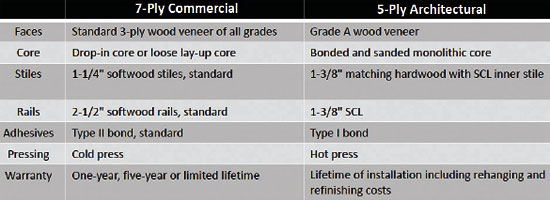 |
|
Source: VT Industries, Inc. |
Industry Aesthetic Standards
Though WDMA is the industry standard for architectural wood door manufacturers, the Architectural Woodwork Standards (AWS) are typically used in installations where the doors are blueprint matched with wall paneling and/or the adjacent millwork. Veneers are manufactured to exact sizes as the manufacturer determines from the blueprints, clipping and matching each individual face to the project's specific needs. Each face is matched in sequence with adjacent panels, doors, transoms, and cabinet faces as needed to provide continuity.
However, most architectural and commercial doors are not directly associated with panels and millwork. Thus, the requirements in WDMA are more than adequate to assure consistent appearance amongst doors. Specifying a Premium door has a higher cost and availability may be a concern because of the limited supply of AA grade veneer, and center balance match and wider flitch requirements (all three of these requirements make sourcing difficult). Premium grade doors should be reserved for special projects and feature areas. Custom is the standard grade that is intended for high-quality appearance and there is no difference in performance between custom and premium doors.
Environmental Concerns
One of the most important contributions wood door manufacturers can make to today's green building initiatives is to produce a durable, sustainable product that remains functional throughout the lifetime of the building and to adapt their manufacturing techniques to ensure environmental responsibility.
Architectural wood doors meet a variety of sustainable building credit requirements of green building programs including recycled content, rapidly renewable materials, regional availability, certified wood, and low-emitting materials. Particleboard and agrifiber cores, for example, as well as high density fiberboard crossbands are manufactured from 100 percent pre-consumer recycled material. Agrifiber doors may also comply with rapidly renewable material and regional availability requirements for manufacturers located in the Midwest.
Third-party certification of wood door products ensures environmental claims are valid. GREENGUARD Certification provides assurance that doors are manufactured and assembled with low-emitting materials, thereby contributing to healthy indoor environments. A key wood certification system is the Forest Stewardship Council (FSC®), which promotes environmentally appropriate, socially beneficial, and economically viable management of the world's forests.
The main objective of FSC certification is to ensure that FSC certified material is tracked through the supply chain. This FSC Chain of Custody (COC) is the path taken by raw materials, processed materials and products, from the forest to the consumer, including all successive stages of processing, transformation, manufacturing and distribution. Manufacturers are FSC COC certified and allowed to label products with the FSC trademarks.
Architectural wood doors also have significant potential to assist with LEED credits. Under the LEED New Construction (NC) rating system, recycled content, regional materials, rapidly renewable materials, certified wood and low-emitting materials credits are all relevant to architectural wood doors. All door manufacturers can assist with the same LEED credits. The amount of assistance can vary based on the construction of the doors. The thickness and width of the core, crossband, stiles, rails, faces, and edges has an effect on the compliant percentages because of the weight differences. These differences are often very slight. Also the location of manufacture and source of materials can affect the amount of regional material available. For FSC doors, one manufacturer may use higher amounts of FSC certified material, while another may use higher amounts of FSC Controlled Wood materials. Every manufacturer is going to have differences that will affect the amount of LEED credit assistance.
Increasingly, manufacturers are making it easy for architects to gauge the LEED potential of their products and complete the paperwork necessary for LEED submittals. Some manufacturers offer calculators that enable architects to explore LEED credit assistance available through specific products. This can take the form of an on-line tool that facilitates comparison of various door types and associated LEED credits. Architects can choose the desired core type and environmental option, which will generate the percentages for all LEED credits applicable to wood doors, even calculating mileage for regional material credit based on the project zip code.
Alternatively, architects can work from LEED credit needed to available products that yield those credits. In some cases, manufacturers' on line capabilities allow architects to create custom LEED specifications including LEED requirements along with aesthetic grade, face material, color finish, fire-rating, and other parameters. In some cases, supporting documentation and manufacturer verification needed for LEED submissions, with a downloadable project specific LEED compliance letter, is available from the manufacturer's website.
Architectural Wood Doors for Performance and Aesthetics
Properly specified, wood doors rank high in terms of performance, aesthetics, and environmental characteristics and can distinguish any building project. A sound understanding of door components, materials, construction methods, and performance standards will aid the designer in selecting the right door for any client goal, be it for standard commercial settings or for enhanced fire protection, superior acoustical performance, or high-traffic applications.
 |
Headquartered in Holstein, Iowa, VT Industries, Inc. is North America's leading manufacturer of architectural wood doors, VT Dimensions countertops, and stone surfaces. The company's three divisions serve customers from nine manufacturing facilities strategically located throughout the U.S. and Canada. For more information, visit the company's website at www.vtindustries.com |
